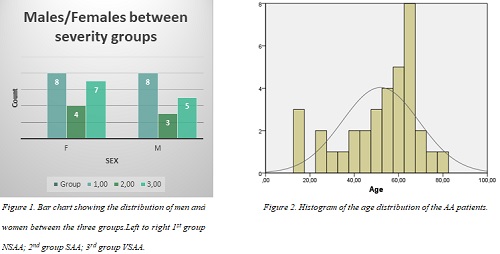
Contributions
Abstract: PB1487
Type: Publication Only
Session title: Bone marrow failure syndromes incl. PNH - Clinical
Background
Aplastic Anemia (AA) is a syndrome characterized by peripheral blood pancytopenia with hypo cellular marrow. Acquired idiopathic AA is still the most common variety. Aplastic anemia’s incidence varies in different geographic areas. In Albania the epidemiology of Acquired AA has not been identified by any study up to now.
Aims
The aim of this study is to identify and describe the epidemiology, including the incidence of Acquired AA in Albania.
Methods
The following study is a retrospective study. Patients diagnosed for the first time between January 2010 and December 2020, at the University Hospital Center (UHC) ‘Mother Teresa’ Tirana, Albania, aged 14 years old and up, were included in this study. The diagnosis of AA patients was confirmed by the bone marrow biopsy hypo-cellularity (less than 25% of cellularity), immunohistochemistry, and by the peripheral blood cytopenias (ANC, Hgb, Plt). The patients were classified into three severity subgroups using the International Aplastic Anemia Study Group. Statistical analysis for this study was performed using SPSS. Categorical and continuous parameters were analyzed using the x 2 test and the T test respectively.
Results
A total of 35 patients were diagnosed as Aplastic Anemia between 2010-2020. The median age was 51 (15-80) years, and 19 (54.3%) were females. Males’ age was slightly higher than the females, mean 54.7 and 49.4 years old respectively. Most of the cases fell under the Non-severe AA group and the Very-severe AA group, 16 and 12 patients respectively. Out of the 35 patients, two were lost to follow, 5 died within the first year following the diagnosis. The incidence of Acquired Aplastic Anemia in Albania is 1.35 per million inhabitants.

Conclusion
The incidence of AA in Albania is lower compared to other studies performed in Europe. In this study the median age of the AA patients was 51 years old, which could be due to environmental factors, whereas other studies have reported a younger median age varying between 19 to 35 years of age. In this study females’ numbers were slightly higher compared to males. In other studies, males were predominant.
Keyword(s): Aplastic anemia, Epidemiology
Abstract: PB1487
Type: Publication Only
Session title: Bone marrow failure syndromes incl. PNH - Clinical
Background
Aplastic Anemia (AA) is a syndrome characterized by peripheral blood pancytopenia with hypo cellular marrow. Acquired idiopathic AA is still the most common variety. Aplastic anemia’s incidence varies in different geographic areas. In Albania the epidemiology of Acquired AA has not been identified by any study up to now.
Aims
The aim of this study is to identify and describe the epidemiology, including the incidence of Acquired AA in Albania.
Methods
The following study is a retrospective study. Patients diagnosed for the first time between January 2010 and December 2020, at the University Hospital Center (UHC) ‘Mother Teresa’ Tirana, Albania, aged 14 years old and up, were included in this study. The diagnosis of AA patients was confirmed by the bone marrow biopsy hypo-cellularity (less than 25% of cellularity), immunohistochemistry, and by the peripheral blood cytopenias (ANC, Hgb, Plt). The patients were classified into three severity subgroups using the International Aplastic Anemia Study Group. Statistical analysis for this study was performed using SPSS. Categorical and continuous parameters were analyzed using the x 2 test and the T test respectively.
Results
A total of 35 patients were diagnosed as Aplastic Anemia between 2010-2020. The median age was 51 (15-80) years, and 19 (54.3%) were females. Males’ age was slightly higher than the females, mean 54.7 and 49.4 years old respectively. Most of the cases fell under the Non-severe AA group and the Very-severe AA group, 16 and 12 patients respectively. Out of the 35 patients, two were lost to follow, 5 died within the first year following the diagnosis. The incidence of Acquired Aplastic Anemia in Albania is 1.35 per million inhabitants.

Conclusion
The incidence of AA in Albania is lower compared to other studies performed in Europe. In this study the median age of the AA patients was 51 years old, which could be due to environmental factors, whereas other studies have reported a younger median age varying between 19 to 35 years of age. In this study females’ numbers were slightly higher compared to males. In other studies, males were predominant.
Keyword(s): Aplastic anemia, Epidemiology


